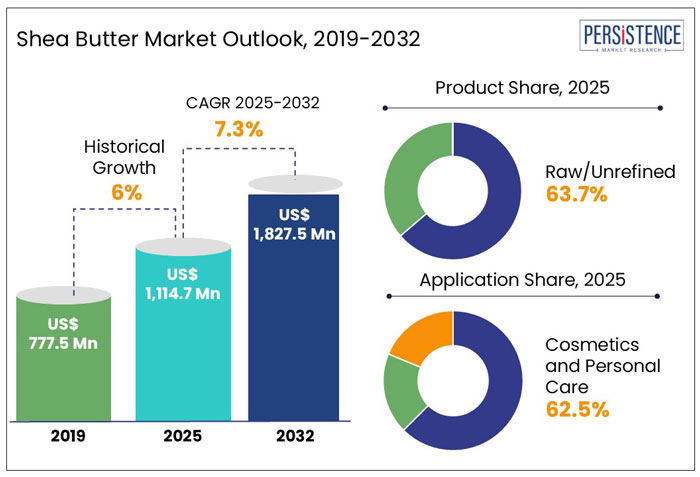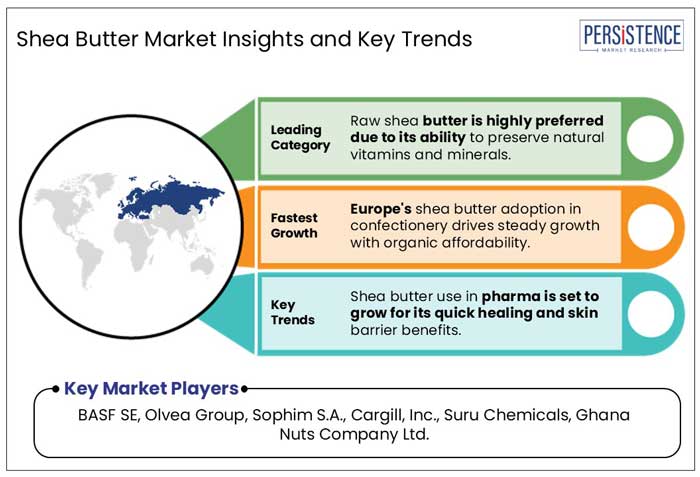Industry: Consumer Goods
Published Date: March-2025
Format: PPT*, PDF, EXCEL
Delivery Timelines: Contact Sales
Number of Pages: 192
Report ID: PMRREP35175
The global shea butter market size is anticipated to reach a value of US$ 1,114.7 Mn in 2025 and is set to witness a CAGR of 7.3% from 2025 to 2032. The market will likely attain a value of US$ 1,827.5 Mn in 2032.
Shea butter was referred to as ‘Women's Gold’ for generations, partly because of the jobs it provided for women across Africa during its cultivation and harvest. It has remained immensely popular since its first recorded use in Ancient Egypt, backed by the surging need for clean label ingredients that can satisfy all-natural and organic requirements.
Shea butter’s high concentration of fatty acids and vitamins makes it an ideal product for conditioning, soothing, and smoothing one’s skin. Several hair care brands are also integrating raw shea butter into their products, especially in shampoo and conditioner, to help treat dandruff and make the hair stronger.
Shea butter is being closely examined for usage in food items, particularly in the production of vegan margarine. Its ability to halt the hydrogenation process that produces trans-unsaturated fatty acids is one of its greatest benefits. This may lead to less fat content, lowering the risk of heart disease by reducing cholesterol levels.

Key Highlights of the Shea Butter Industry
|
Global Market Attributes |
Key Insights |
|
Shea Butter Market Size (2025E) |
US$ 1,114.7 Mn |
|
Market Value Forecast (2032F) |
US$ 1,827.5 Mn |
|
Projected Growth (CAGR 2025 to 2032) |
7.3% |
|
Historical Market Growth (CAGR 2019 to 2024) |
6.0% |
Leading Beauty Brands Boosted Shea Butter Demand in Hair and Skincare Products during Historical Period
As per Persistence Market Research, in the historical period from 2019 to 2024, the global shea butter industry witnessed an average CAGR of around 6.0%. This period saw leading beauty brands like Unilever, The Body Shop, and L’Oréal incorporate shea butter into their hair care and skincare formulations.
L’Oréal, for instance, broadened its shea butter-based product offerings in the historical period, especially through its premium brands like Garnier, Lancôme, and Kiehl’s. The ingredient became a staple in Kiehl’s Ultra Facial Cream. The product gained immense popularity due to its ability to protect one’s skin from external environmental factors and promote intense hydration.
The Body Shop has been a pioneer in utilizing sustainably sourced shea butter. Its Shea Body Butter was one of the best-selling products worldwide. This was attributed to increasing customer demand for deeply moisturizing and natural skincare products.
The brand further launched a 100% Natural Shea Butter Balm and Shea Butter Hair Mask in 2020 to attract customers toward unrefined and pure formulations. It promoted the Community Fair Trade program by sourcing shea butter directly from Ghana’s women’s cooperatives.
Unilever launched Shea Butter & Warm Vanilla Body Wash under the Dove brand. It instantly became a best-seller backed by its nourishing formulation. The company’s Love Beauty and Planet brand further introduced body washes, conditioners, and shampoos infused with shea butter.
Forecast Period to Witness Adoption of Shea Butter in Pharmaceuticals like Topical Ointments for Dermatitis
From 2025 to 2032, the shea butter industry is likely to showcase a steady CAGR of 7.3%. The period is estimated to see increasing demand for the ingredient in the pharmaceutical industry. It is likely to find extensive use in topical formulations for the treatment of conditions like dermatitis, psoriasis, and eczema. This is attributed to shea butter’s emollient properties.
It is also being used in ointments and lotions for dry and irritated skin due to its ability to improve skin barrier function and accelerate healing. Salve Pharmaceuticals Pvt. Ltd., for example, recently launched a new line of skincare products under ‘Ultra.’ The products under this range are made of shea butter to promote skin-nourishing benefits. More pharmaceutical companies are anticipated to come up with new products, thereby spurring the market.
Regulatory Frameworks to Ensure Sustainability, Safety, and Quality in the Global Market
International collaborations and regulatory frameworks that help enhance product quality, safety, and sustainability are directly related to market growth. Strict FDA and USDA rules in the U.S. ensure customer safety, prohibit adulteration, and improve accurate labeling for shea butter products.
The rules are important for maintaining consumer trust in the market, especially when it comes to preventing shea butter from being adulterated, which is a key problem in the U.S. Imported shea butter is divided into various segments by the American Shea Butter Institute, which highlights the significance of using pure, high-quality shea butter for its effectiveness.
Strategic partnerships between organizations in Africa and the U.S. are further boosting sustainable practices and economic empowerment in the market. The initiative called ‘Shea Gets Greener!’, a partnership with USAID, Sundial Brands, and The Savannah Fruits Company, is anticipated to empower around 21,000 women in Mali, Cote d'Ivoire, and Ghana.
The initiative, which includes an investment of US$ 9.3 Mn, is estimated to help promote eco-friendly production methods and improve efficiency. Such initiatives are likely to broaden the market growth trajectory by enhancing the supply chain and complying with sustainability standards.
Changing Land-use Regulations May Disrupt Shea Tree Regeneration in Ghana’s Parklands
Although shea butter-based products appear to be abundant in markets and beauty counters around the world, there are certain hidden dangers to shea trees. The threat to Ghana's shea parklands, which are agricultural landscapes with shea trees scattered across grain fields, was deemed a national priority by the country's Vice President in April 2021.
Long-standing land-use regulations are being altered by pressures on the land. Shea trees naturally reproduce when there is no cropping, or during fallow periods. The fallow period is shortening as the number of people living in rural areas is rising and more land is being used to plant crops.
The shea stands may become old and eventually yield less if there are no young trees left. Mechanization with tractors and oxen-drawn plows is encouraged by efforts to increase grain and other crop yields. However, with automated tillage, trees on the fields can become an inconvenience and take up space that could be used for commercial crops like cotton that are usually supported by the government.
Emergence of Shea Cooperatives to Help African Women Access Global Markets
The only product produced solely by women worldwide is shea butter. In West and East Africa, an estimated 20 Mn women work directly in the shea industry. Shea controls a significant portion of the foreign exchange inflows for 7 countries in West Africa, including Burkina Faso, and holds a market share of millions of dollars. However, this accomplishment barely helps those women working at the beginning of the supply chain. They rely on middlemen who pay them poor prices and sell their shea locally.
Other challenges like desertification exist in Africa. The soil is constantly drying out, making it more prone to erosion and less fertile. Another important issue is logging. Several small-scale farmers are burning trees and shrubs to make space for more agricultural land. They are also cutting down a lot of trees for cooking or for firewood. The landscape may eventually deteriorate, and shea trees may be endangered after a certain period.
As the global demand for shea butter is rising steadily, several companies like Cordaid are striving to gain opportunities by taking initiatives for women in Africa. The company joined hands with a Dutch firm called Vogelbescherming to help protect bird species and their environment.
The new Birds, Bees and Business program is backed by the Dutch Postcode Lottery. The partnership would help create market opportunities for nearly 22,000 women in Burkina Faso and support nature restoration. Approximately 440,000 new trees will soon be planted, which includes shea trees, to prevent desertification and restore biodiversity. Birds will have a place to hibernate again, bees and other insects may pollinate, and eventually, the area will have more shea trees.
Women will receive training on how to produce high-quality, sustainably sourced shea butter that caters to global market standards. To access local and global markets and get a reasonable price for their products, the company would help establish cooperatives.
Raw Shea Butter to Gain Momentum as it Preserves Natural Vitamins and Minerals
Raw/unrefined shea butter is anticipated to generate a significant share of around 63.7% in 2025. This type of shea butter is mainly preferred because of its ability to preserve natural bioactive compounds, minerals, and vitamins that usually diminish during the refining process.
Raw shea butter also has anti-inflammatory properties, which are ideal for use in skincare products to prevent conditions like swelling, itching, dermatitis, and eczema. Companies are now promoting collagen production and new cell generation properties of raw shea butter through their launch of moisturizers and face creams.
Refined shea butter, on the other hand, is projected to see decent growth through 2032 backed by its high shelf life. It offers a neutral base for cosmetic formulations. However, the refining process takes away beneficial nutrients, lowering the ingredient’s therapeutic efficacy.
Non-greasy Yet Emollient Nature of Shea Butter to Make it a Key Anti-aging Ingredient
Based on application, the cosmetics and personal care segment will likely account for a shea butter market share of nearly 62.5% in 2025. Superior skin-repairing, anti-inflammatory, and moisturizing properties of shea butter are set to raise its adoption in the cosmetics and personal care industry. The ingredient contains fatty acids like oleic, stearic, and linoleic acids that deeply nourish the skin without clogging pores, in contrast to synthetic emollients.
Brands like The Body Shop and L’Occitane are constantly using shea butter to make facial creams, lip balms, and body butters. They aim to cater to customers looking for sustainable and natural skincare solutions. Also, shea butter’s non-greasy yet highly emollient nature is set to make it highly popular among brands producing anti-aging products. Brands like Drunk Elephant and Kiehl’s, for instance, have been using the ingredient in eye creams and moisturizers.
The global food industry, on the other hand, is showcasing a rising demand for cost-effective and sustainable alternatives to vegetable fats. Chocolate and confectionery brands are using shea butter as it has a similar composition to that of cocoa butter. Apart from confectionery, the ingredient is being used as a healthy alternative to hydrogenated fats in frying oils, margarine, and baked items.

West Africa’s Shea Belt to Strengthen its Role in Global Shea Butter Production with Government Initiatives
In the Middle East and Africa, countries like Nigeria, Ghana, Mali, Cote d'Ivoire, Benin, and Burkina Faso are projected to play a key role in the production of shea butter. These countries are called the ‘Shea Belt’ of West Africa.
Vast swathes of shea trees can be found in Nigeria, especially in its northern parts. This natural resource offers the foundation for a booming shea butter industry in the country. The country’s government has put forward several initiatives to support the industry’s growth. It has recently started promoting sustainable harvesting and processing techniques, investing in infrastructure development, and conducting training programs for small-scale producers.
In Ghana, shea butter is considered one of the most significant export commodities. According to Ghana Export Promotion Authority (GEPA), as shea butter is an ideal substitute for cocoa butter, whenever the cost of cocoa rises, demand shifts toward shea butter worldwide. GEPA also mentioned that countries like Saudi Arabia, Türkiye, Sweden, Dubai, and Kuwait tend to use shea butter from Ghana for processing chocolates. Hence, the country has been showcasing a rising demand for shea nuts and butter.
The market for shea butter in Cote d'Ivoire, on the other hand, is set to showcase a steady CAGR through 2032. The country houses Bio Amandes, the only processor, producer, and exporter of shea butter that is certified as per international organic and fair-trade standards. The company focuses on producing 2,000 tons of shea butter every year instead of the 500 tons it is currently producing. In addition, it announced its plan to create 140 new jobs in 2025 to help operate the extended facilities in Ferkéssédougou.
Ingredient Suppliers in the U.S. Focus on Obtaining Approvals for Shea Butter-based Products to Extend Applications
North America is projected to witness a steady demand outlook for shea butter in the foreseeable future. It is attributed to increasing demand for organic ingredients from cosmetics and food industries.
The U.S. shea butter market is anticipated to remain at the forefront as several ingredient companies in the country are focusing on obtaining fast-track approvals from the Food and Drug Administration (FDA) to market their shea butter-based products. For instance,
Similar ingredient approvals by government agencies in the U.S. are projected to create new growth prospects in the forecast period.
High Popularity of Shea Butter as a Palm Oil and Dairy Butter Alternative in the U.K. to Create Avenues
Europe is likely to have robust potential for shea butter in food items with its growing bakery and confectionery industry. The region is projected to hold a share of around 31.2% in 2025. A few promising markets in Europe are the U.K., France, and Germany.
Shea butter has gained popularity among modern consumers in recent years, mainly due to its representation on cosmetic labels. However, as per the Ministry of Foreign Affairs, the food industry in Europe uses nearly 90% of the total volume of exported shea, whereas the remaining 10% is used in cosmetics.
The U.K. bakery industry is gradually replacing palm oil and dairy butter with shea butter. It is capable of providing the same flakiness, crumb, and texture in cakes, cookies, and pastries. Various local bakeries have started using shea butter in items like croissants to attract vegan consumers. Pret a Manger, for instance, launched ‘Very Berry Croissant’ in January 2020. It included sunflower oil and shea butter instead of dairy butter.
In France and Germany, shea-based Cocoa Butter Equivalents (CBE) are being infused with cocoa butter to prepare chocolate and chocolate-based products. Shea butter is considered a superior improver with beneficial organoleptic properties. In both countries, products made with CBEs are allowed to be distributed and marketed as chocolate when their non-cocoa butter fats percentage is less than 5%. Such favorable norms are anticipated to create new opportunities in the countries.
The global market for shea butter houses several large- and small-scale companies competing for high shares. They are mainly focusing on entering Ghana, one of the most prominent exporters of unrefined shea butter in the world.
Companies are also striving to introduce novel techniques for smooth shea processing. They are joining hands with government bodies to take various initiatives for women, who play an important role in the shea butter industry across countries in West Africa.
Key Industry Developments
|
Report Attributes |
Details |
|
Historical Data/Actuals |
2019 - 2024 |
|
Forecast Period |
2025 - 2032 |
|
Market Analysis Units |
Value: US$ Bn/Mn, Volume: As applicable |
|
Geographical Coverage |
|
|
Segmental Coverage |
|
|
Competitive Analysis |
|
|
Report Highlights |
|
|
Customization and Pricing |
Available upon request |
By Product
By Application
By Region
To know more about delivery timeline for this report Contact Sales

The market is set to reach US$ 1,114.7 Mn in 2025.
The industry will likely be valued at US$ 1,827.5 Mn in 2032.
The industry is set to surge at a CAGR of 7.3% through 2032.
BASF SE, Olvea Group, Sophim S.A., and Cargill, Inc. are a few key players in the industry.
The cosmetic and personal care industry is the target market for shea butter.